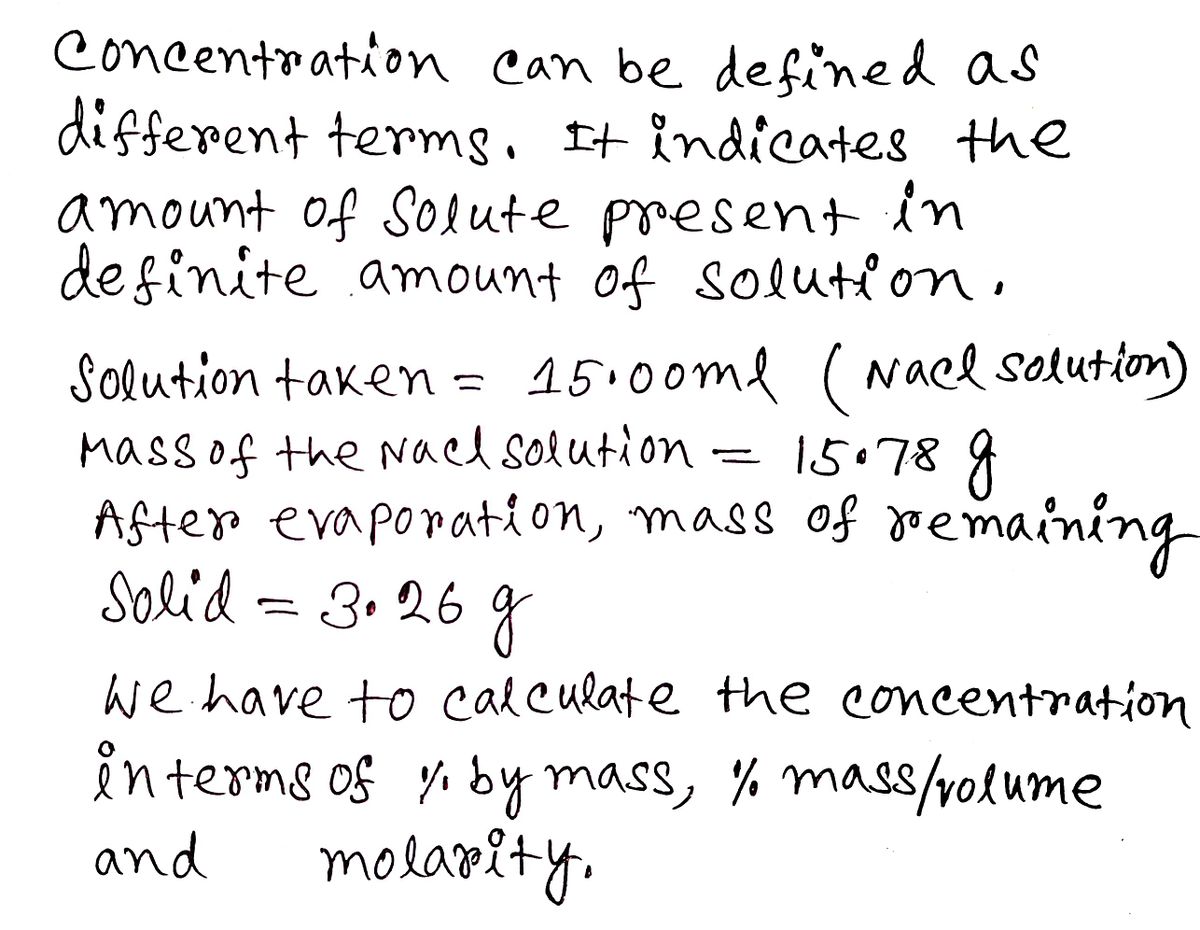15.00 mL of a NaCl solution that has a mass of 15.78 grams is placed in an evaporating dish and heated to concentrations for the dryness. The remaining solid has a mass of 3.26 grams. Calculate the following solution: % by mass, % mass/volume, and molarity.
15.00 mL of a NaCl solution that has a mass of 15.78 grams is placed in an evaporating dish and heated to concentrations for the dryness. The remaining solid has a mass of 3.26 grams. Calculate the following solution: % by mass, % mass/volume, and molarity.
Chemistry
10th Edition
ISBN:9781305957404
Author:Steven S. Zumdahl, Susan A. Zumdahl, Donald J. DeCoste
Publisher:Steven S. Zumdahl, Susan A. Zumdahl, Donald J. DeCoste
Chapter1: Chemical Foundations
Section: Chapter Questions
Problem 1RQ: Define and explain the differences between the following terms. a. law and theory b. theory and...
Related questions
Question
I do not understand this pre lab question

Transcribed Image Text:the concentration of a solution, simply because molarity is defined in terms of moles and moles are directly
related to the stoichiometry of reactions. Moles are defined as the grams of solute divided by its molar
mass.
In this experiment a solution of sodium chloride of unknown concentration will be used. You will
measure the mass of a known quantity of NaCl solution. The sample will be heated to evaporate the water
until it is dry. The mass of the sample after heating represents the mass of NaCl in the mixture. The
concentration of NaCl will be determined by the three methods mentioned above.
PRELABORATORY QUESTIONS
15.00 mL of a NaCl solution that has a mass of 15.78 grams is placed in an evaporating dish and heated to
dryness. The remaining solid has a mass of 3.26 grams. Calculate the following concentrations for the
solution: % by mass, % mass/volume, and molarity.
EXPERIMENTAL PROCEDURE
PART A: WATER CONTENT IN FOOD
1. Label three watch glasses as 1-3. Measure their masses to the nearest 0.01 grams and record the
values in the notebook.
2. Cut several thin slices of a fruit or vegetable and arrange it on the watch glass label 1
as far apart as possible. Record the type of foods used.
3. Now weigh the watch glass with the food. Record in your notebook.
Repeat the procedure (steps 2 and 3) with other 2 different types of fruit or vegetables. Be careful that
step
Expert Solution
Step 1: Introduction to concentration

Step by step
Solved in 5 steps with 5 images

Knowledge Booster
Learn more about
Need a deep-dive on the concept behind this application? Look no further. Learn more about this topic, chemistry and related others by exploring similar questions and additional content below.Recommended textbooks for you

Chemistry
Chemistry
ISBN:
9781305957404
Author:
Steven S. Zumdahl, Susan A. Zumdahl, Donald J. DeCoste
Publisher:
Cengage Learning

Chemistry
Chemistry
ISBN:
9781259911156
Author:
Raymond Chang Dr., Jason Overby Professor
Publisher:
McGraw-Hill Education

Principles of Instrumental Analysis
Chemistry
ISBN:
9781305577213
Author:
Douglas A. Skoog, F. James Holler, Stanley R. Crouch
Publisher:
Cengage Learning

Chemistry
Chemistry
ISBN:
9781305957404
Author:
Steven S. Zumdahl, Susan A. Zumdahl, Donald J. DeCoste
Publisher:
Cengage Learning

Chemistry
Chemistry
ISBN:
9781259911156
Author:
Raymond Chang Dr., Jason Overby Professor
Publisher:
McGraw-Hill Education

Principles of Instrumental Analysis
Chemistry
ISBN:
9781305577213
Author:
Douglas A. Skoog, F. James Holler, Stanley R. Crouch
Publisher:
Cengage Learning

Organic Chemistry
Chemistry
ISBN:
9780078021558
Author:
Janice Gorzynski Smith Dr.
Publisher:
McGraw-Hill Education

Chemistry: Principles and Reactions
Chemistry
ISBN:
9781305079373
Author:
William L. Masterton, Cecile N. Hurley
Publisher:
Cengage Learning

Elementary Principles of Chemical Processes, Bind…
Chemistry
ISBN:
9781118431221
Author:
Richard M. Felder, Ronald W. Rousseau, Lisa G. Bullard
Publisher:
WILEY